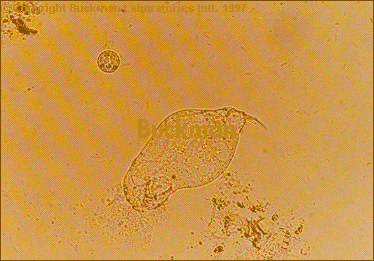 |
|
|
 |
|
 |
|
|
Protozoa is a plural collective name for animal-like microorganisms that carry out all of their life functions within the confines of a single complex cell. They are classified as part of the Protista Kingdom, one of the Five Kingdoms of living organisms. Protista species are single-celled with a membrane enclosed nucleus. More than 20,000 species are known, including the more commonly known forms of ‘paramecium’ and ‘amoebae’. They Vary in length from two to seventy microns. Protozoa are found in most of the earth’s habitats, but most of the species live in aquatic habitats of oceans, rivers, lakes, ponds, and marshes. Relative abundance in the marine vs. fish water habitats is unknown. They obtain their nutrients through ingesting bacteria, waste products of other organisms, algae, fungi, or other protozoa. They are predatory in nature, some closely related to animals, others related to plants, and still others are quite unique. Many species have limited distribution, while others can be found distributed throughout the world. Unicellular photosynthetic protozoa are sometimes called algae, and can produce their own food to some extent. Heterotrophic protozoa exclusively rely on outside sources for their supply of food, as they have no means to produce their own. Most free-living protozoa reproduce by means of cell division. Symbiotic Protozoa are parasites, and are infamous for their role in causing disease in plants, animals, and humans. Many free-living and parasitic species are obligatory anaerobes, as they grow without the need for atmospheric oxygen. The abundance an diverse nature of protozoa can be used as indicators of pollution, both organic and toxic. Polluted waters are often rich in protozoans and in freshwater systems, they can be measured to indicate levels of toxicity and ultimate environmental quality. In dry land habitats, soil dwelling protozoa are present in almost every type of soil and environment, from peat-rich soils to the dry soils of the deserts. They are found in greatest abundance near the soil surface, especially in the first six inches, but can be found at depths to three feet. In soils, protozoa do not generally represent a major part of the total soil biomass. They play an important role in the ecological health of the soil and subsequently the microbial food chain. They are an essential element of the soil microbial community both as a waste digester, herbivore, and predator in microbial balance and population control. In the soil microbial community, protozoa are also an important food source for micro invertebrates, and they are therefore important in the transfer of bacterial and algal production. Commonly recognized phyla of protozoa: flagellated Zoomastigena amoeboid Sarcodina amoeboid Foraminfera amoeboid Radiolaria ciliated Ciliophora
Cnidosporidia Sporozoa
|
| [Welcome] [ViTech Home] [About Vitech] [Site Map] [Soil Building] [Plant Nutrition] [About Nutrients] [Soil Blends] [Foliar Blends] [Elemental Products] [Inquiries & Links] [Reference Data] |
|
